Toyota RAV4 Woodland vs. Subaru Forester: The Ultimate Off-Road Hybrid Showdown
The Toyota and Subaru hybrid are affordable, capable, and reliable AWD SUVs that borrow incredible technology from each other. So, which one is best?

If you go to the downtown area of your closest city, we’d bet you’d spot a ton of Toyota RAV4 SUVs and Subaru Foresters. And there’s a good reason for that: both companies have ironed out the wrinkles to make a near-perfect mid-sized SUV. They’re both large enough to fit the family but small enough to fit in the garage, are comfortable for long trips, and have enough cargo space to help families go the distance.
And, in a few months, Subaru will have a hybridized version of its Toyota competitor for sale for around the same price as the RAV4. So, Toyota is about to have serious competition for the Woodlands Hybrid edition coming down the pike. The RAV4 hybrid is one of Toyota’s best-selling vehicles for the same reasons as above, but it gets better mileage. Now, Subaru enthusiasts are excited to experience the same thing in a Forester.
So, if both family-friendly and adventure-thirsty SUVs are priced almost identically, share similar technology, and are made to be able to tackle your family’s camping trips and grocery hauls, which one is the best? Let’s see what makes them different to help you make an informed decision before heading to the dealership.
This story is 100% human-researched and written based on actual first-person knowledge, extensive experience and expertise on the subject of cars and trucks.
Let’s Talk Price Versus Mileage—Both Equal Exceptional Value

The Subaru Forester hybrid and Toyota RAV4 Woodland hybrid are similarly priced. The Subaru starts at $34,995 and goes up to $41,695 for the Touring Hybrid Edition. The maximum price is $44,005 if you include the most expensive paint option ($895) plus the destination and delivery fee ($1,420).
The Toyota is naturally a little more expensive thanks to it being chockablock full of technology. The starting MSRP is $35,520., Since the Woodland is a trim of the RAV4 hybrid, the pricing isn’t flexible. If you opt for the PHEV version (which wasn’t discussed in more detail because that’s not a fair comparison, as Subaru doesn’t offer a Forester PHEV), it has an MSRP of $49,530.
As far as mileage is concerned, Toyota’s webpage for the Woodland hybrid says the estimated mileage on the highway is 38 city, 35 highway, and 37 combined. Subaru’s website says the Forester hybrid gets 35 mpg in the city and 34 on the highway, and 29 mpg combined. Overall, the Forester is said to have an overall range of 581 miles, while the Toyota’s range is 460 miles.
The Two Companies Share Their Best Technology
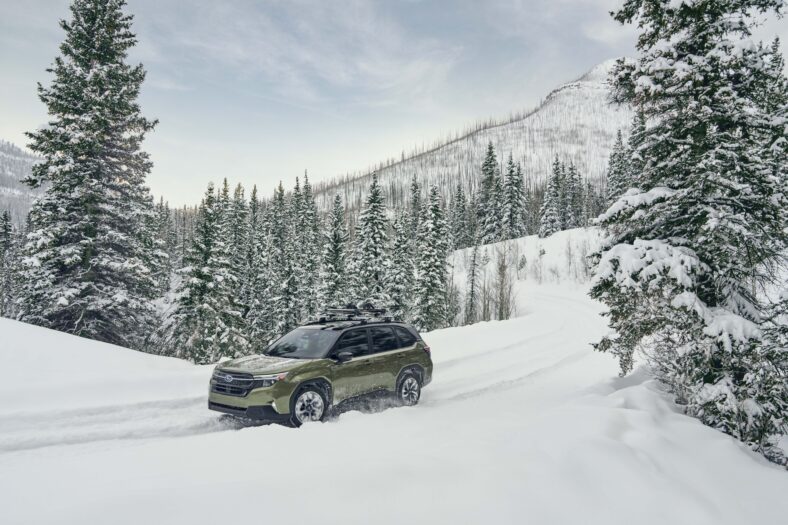
Toyota has been investing in Subaru since 2005 after the company bought 10% of GM’s stake in Fuji Heavy Industries, Subaru’s parent company. In 2019, Toyota increased its share percentage to 20%. For a business, that seems like a scary number, however, Subaru operated independently from Toyota Motor Company.
Toyota and Subaru’s partnership ended up benefiting both companies, as Toyota has some of the best hybrid technology in the industry, and Subaru’s Symmetrical AWD technology remains undefeated. Seeing an opportunity to improve each other’s lineups, they came to an agreement. Any hybrid by Subaru features Toyota hybrid technology, and any gas-powered AWD car from Toyota has Subaru’s award-winning AWD technology.
Therefore, both the RAV4 Woodlands Hybrid and the Subaru Forester Hybrid feature the best from both companies. But, there are subtle enough differences to make them opponents rather than twins under different companies.
Related: 8 Worthy SUV Alternatives to the Subaru Outback
The First Difference to Note is the Engine
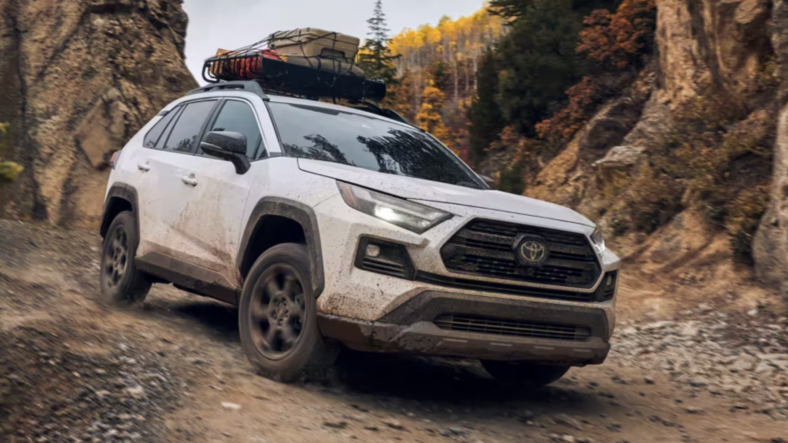
Of course, the Forester Hybrid wouldn’t be a Subaru without a Boxer engine. Under the hood is the company’s 2.5-liter four-cylinder Boxer engine paired to a single electric motor to generate a combined 194 horsepower. It’s not terrible for an SUV that isn’t designed for the race track, but it’s vastly different from Toyota’s 219 horsepower from the company’s 2.5-liter four-cylinder engine.
Neither has a turbo bolted onto the engine, but there are three electric motors in the RAV4. One in the front, one in the rear, and one for the engine to make that combined horsepower figure. So, if a little more pep in your step is important for your trek to the campsite, the Toyota is the one for you.
However, it should be noted that Subaru did say the Forester hybrid’s acceleration will be improved by 10 to 15% because of the electric motor, so don’t peg the Subie as a slow poke just yet.
Then There’s the Trail Readiness
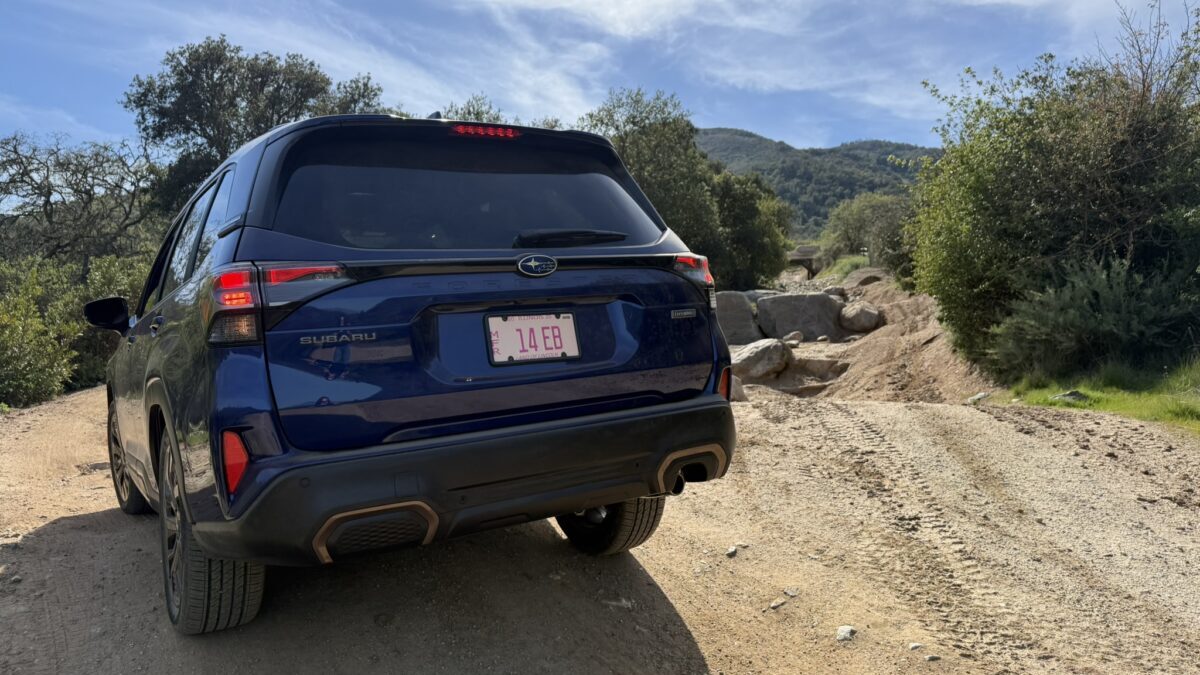
Part of the advertisements for the Forester was its trail-readiness. Every generation of Subaru Forester has been impressive off-road, thanks to its Symmetrical AWD paired with respectable approach and departure angles. Oh, and the ground clearance.
The Forester Hybrid will have Subaru’s standard height of 8.7 inches, which is higher than the RAV4 by 0.6 inches. However, we all know that ground clearance and AWD won’t mean much without proper tires. The Forester Hybrid will come with all-season tires, likely from Yokohama, while the RAV4 Woodlands Hybrid comes with grippy, knobby, and well-loved Falken Wildpeak all-terrain tires.
But, don’t count the Forester out just yet. Subaru’s X-MODE tunes the car’s CVT for a variety of terrain modes, like Snow, Dirt, Deep Snow, and Mud, while the RAV4 has a single “Trail” mode designed for “uneven surfaces.” However, the TRD-Tuned suspension setup means the Toyota hybrid is simultaneously comfortable and capable. The Subaru’s suspension is the standard setup—you’d need to get the non-hybrid Wilderness edition to match the suspension on the Toyota.
Lastly—and this is a bit nerdy—but Subaru’s all-wheel drive is a true, mechanical system while Toyota’s is electronic. The engine powers the front axle, while the rear electric motor powers the rear axle, so there’s no physical connection between the rear axle and the engine. When the going gets tough, Subaru’s all-wheel drive will be more effective off-road as the engine’s torque and power is evenly distributed. So, it all depends on how often you plan to go off-road.
Interior Design is Subjective, But the Subaru Sure is Bigger on Tech
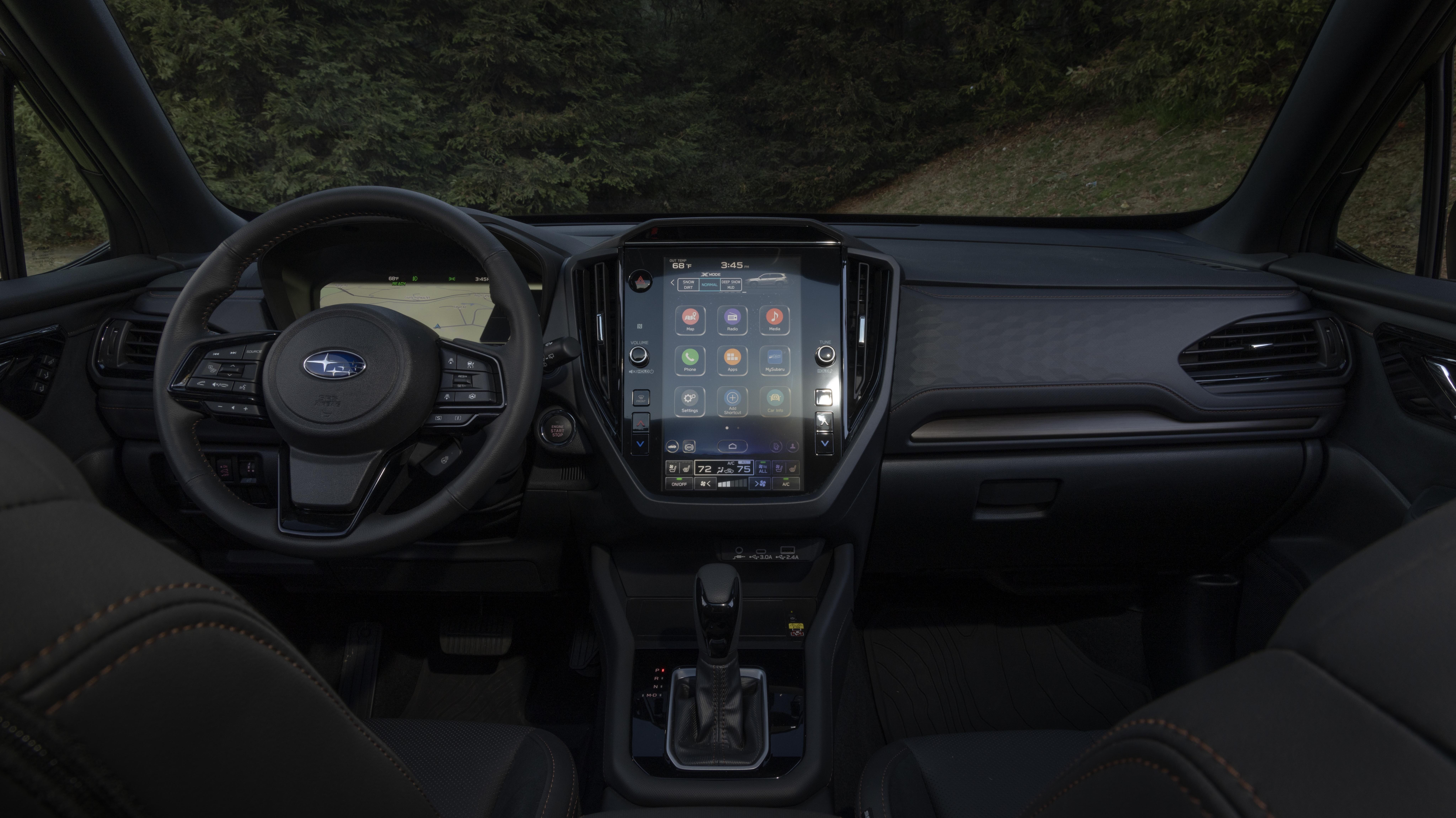
I’ve always been a snob when it comes to interiors. After all, you spend 99.9% of the time inside the car rather than outside, so it has to be nice to look at, easy to use, and easy to become acquainted with. Both have wireless Android Auto and Apple CarPlay, digital gauges, and driver information.
The Forester Hybrid will have an 11-speaker Harman Kardon system for the Sport and Touring trims, and it can be added on as an option. As you can see by the picture, many of the driver functions are within a screen, including the seat heater and climate controls (though there are quick buttons on the side for the driver and passenger).
A traditional shifter is included, too. However, the most notable thing about the Forester over the RAV4 hybrid is the seating. The Forester Hybrid can have Subaru’s StarTex waterproof seating included, making cleaning up after lake days, hiking trips, and summer days by the river much easier to clean up.
READ MORE: 2023 Toyota RAV4 Hybrid Limited: The Car I Wish We’d Purchased
The Toyota’s Interior is More Old School
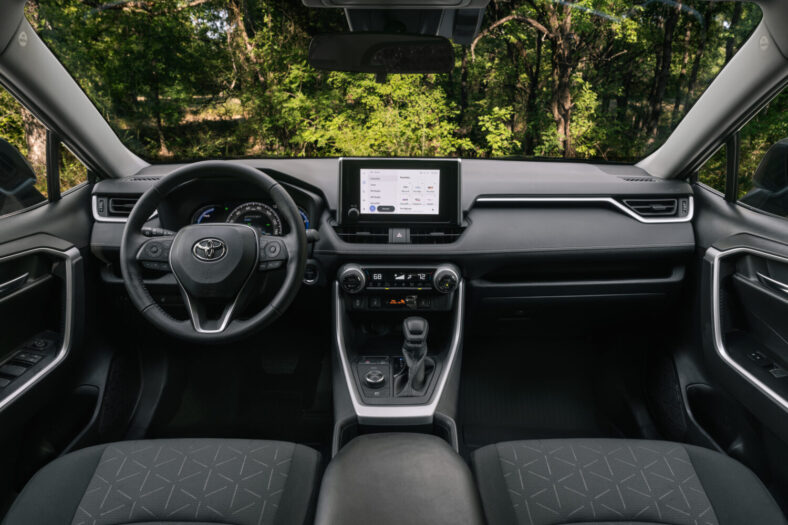
Toyota’s infotainment screen is notably smaller than the one in the Subaru, and common driver functions are buttons and knobs rather than being buried in a screen. Like the Subaru, it also has a traditional shifter, making it easier to get used to. The gauges are digital like the Subaru, and they’re much easier to read and easy to customize.
The standard 6-speaker setup can be swapped for an 11-speaker JBL sound system with a dedicated subwoofer before delivery, too. The Forester doesn’t have a dedicated subwoofer, so the sound system would be a lot clearer in the Toyota.
Additionally, Subaru says the cabin will be quieter than the Foresters before it, but the Toyota has sound-dampening technology to reduce road noise when driving, making it quieter than the Subaru straight from the factory.
Both are Armed with Industry-Leading Safety Features
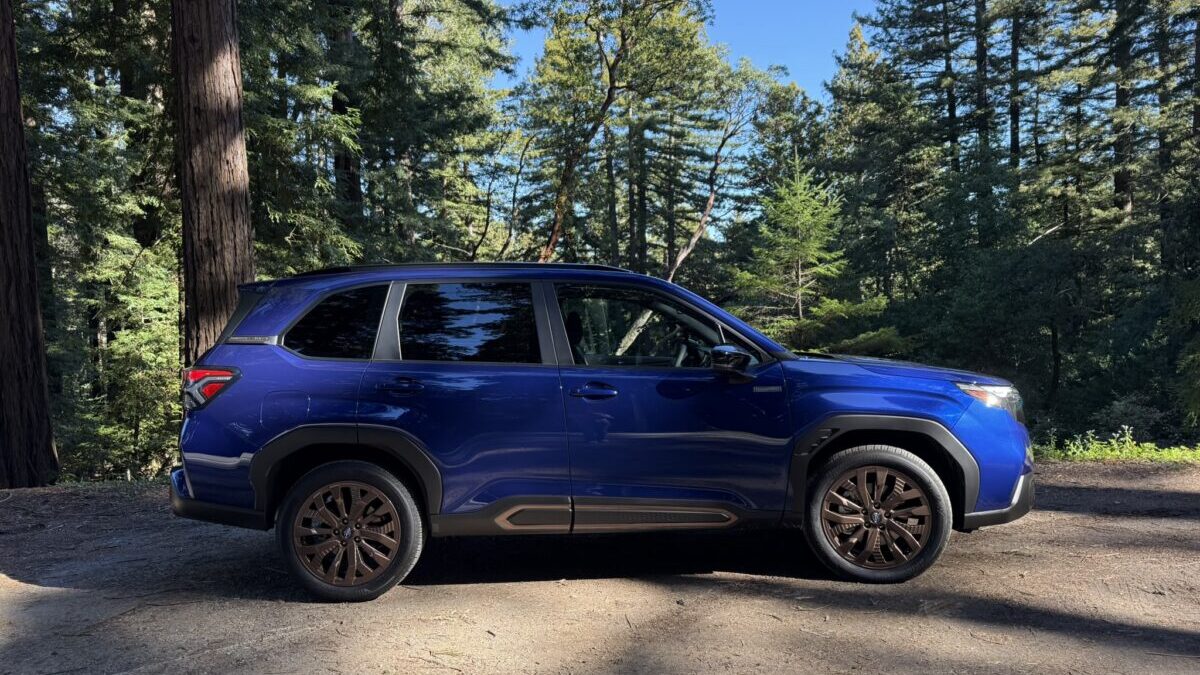
Both Subaru and Toyota pack a powerful punch when it comes to their safety suites. Subaru’s EyeSight is a tri-camera system that has pedestrian detection, cross-traffic alerts for both sides, front, and rear, rear and front-facing cameras, emergency braking, lane keep assist, road sign detection, sway warning, and adaptive cruise control.
Toyota’s system offers the same features, but its Safety Sense works a little differently. Instead of cameras, Toyota’s system utilizes radar. Radar is best for most situations, as cameras can be obstructed by rain, poor lighting, and fog. However, Subaru’s EyeSight has proven to be the only manufacturer’s safety system that can detect pedestrians at night, regardless of what they’re wearing. In fact, Subaru’s EyeSight is the best rated for emergency braking.
Cameras are better for close-range detection, making it ideal for pedestrian-heavy city life, as the computer analysis is more efficient. Radars are better for climates that have seasons with fog and heavy rain, as radar isn’t affected by those elements like cameras are.
However, both are named as Top Safety Picks by the Insurance Institute of Highway Safety (IIHS), so you wouldn’t be losing with either choice. It would just depend on whether radars or cameras better suit your lifestyle.
READ MORE: 10 Reasons Subaru Owners Are So Loyal—And Yes, Love and Puppies Are on the List!
The Toyota Hybrid Wins in Regards to Cargo Space… With a Catch

As far as room for the family goes, the Toyota hybrid takes that trophy. The trunk space in the Woodlands edition is 37.6 cubic feet compared to the Subaru’s 26.9 cubic feet. However, the Subaru has more vertical headspace, making it better for taller passengers and drivers. It also increases visibility, thanks to taller windows.
When the rear seats are folded, the Toyota wins again with 69.8 cubic feet over the Forester hybrid’s 58.8 cubic feet. Those numbers may seem great on paper, but due to their similarities in length, width, and wheelbase length, a higher cargo space number translates to less space overall for passengers.
It’s also worth noting that both SUVs come with roof rack rails, making it easy to fit a cargo box or basket to the roof to fit more gear for the annual family camping trip.
So, What’s the Verdict?
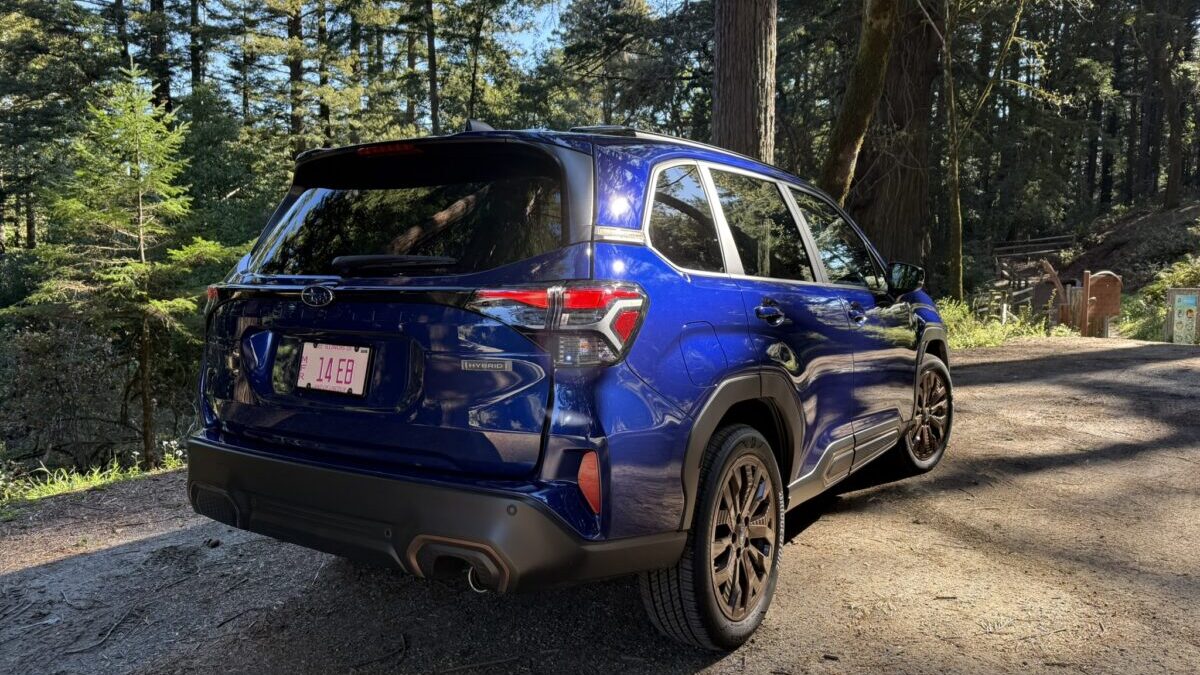
Both are excellent choices, there’s no doubt about that. However, the subtle differences can add up to a lot depending on your lifestyle.
You’d benefit the most from the Forester if you frequently traverse more serious trails where cargo space, a true AWD system, ground clearance, and approach and departure angles make the most difference. And if you frequently have passengers in the back, like kids, car seats, or other adults, as there’s more space for passengers.
The Toyota is the one for you if you tackle lighter trails, need more cargo space for gear over passengers, and travel longer distances frequently, as the mileage is a tad better (thanks to a front-wheel drive bias unless slipping is detected).
Pricewise, they’re very, very similar at the base level. If you’re going for the Limited Touring edition, though, the Forester becomes more expensive than the RAV4. The choice between the two is a hard one—but hopefully this comparison helped you narrow it down a tad.
More About:Car Buying
